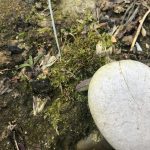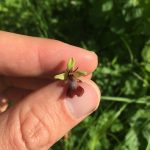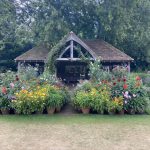If you’re starting to think about new plants for your garden, as I am, my best advice to you is to follow the below steps to selecting plants like a pro. Follow these tips for the best chance of success, reducing disappointment. There are thousands upon thousands of plants available today in the UK and thanks to the internet, we can research them better to find out if they are suitable for our gardens. It’s always tempting to go with what we know or what looks best in the nursery, but I never plant gardens in this way. I will always use data and a bit of desk research when selecting plants.
1) Annual, biennial or perennial?
Annuals live for one year, biennials grow in the first year, flower and die in the second. Perennial plants will keep coming back year after year. Many people say to me they picked up some lovely plants in the garden centre only to find they eventually die. When I ask what the plant was, there are usually two reasons. First, the plant was an annual like cosmos or a biennial like a foxglove, destined to eventually die. Second, the plant is a perennial and hasn’t actually died, it’s just gone dormant in winter. My advice, especially to beginner gardeners, is to focus on perennials because most will grow for years, growing larger and can then be divided for free plants. By all means do grow annuals and biennials, they are brilliant if they self sow like foxgloves, but make a note to remember these will die eventually.
2) Final height and width
This is super important. If you take one thing from this list, take this point. When you look at plants online and on plant labels in shops, you should find the eventual height and width of a plant. Always plan to plant it to that size, not to how it is when you get it. I know it’s tempting to squeeze a beautiful little shrub from a garden centre into a 50cm gap in your garden, but if it will eventually become a 4 x 4m witch hazel, it will soon outgrow the spot or pot! As a designer, I never plant anything in a spot with a view to cutting it to keep it to size – this creates far more work, which is easy to forget doing, and usually ends up with ugly chopped up plants. Stick to this rule, and plants will grow happily side-by-side, without crowding each other out. And it will make less work for you.
3) Hardiness
In the UK our hardiness ratings go from H1 which is for tender plants that can’t survive our winters, to H7 for super hardy able to survive any cold (H = hardiness). When we lived in London I would grow plants with an H3 rating (able to survive to -5C) or higher, up to H7 (able to survive temperatures lower than -20C!) To be totally sure, I would only grow a plant with an H4 rating, able to survive to -10C. Up in northern England, I now only plant things with an H4 – H7 hardiness rating because I know they will survive. While it’s tempting to try a plant with a lower rating, hoping for the best, to avoid disappointment, put that to one side and research the other thousands of plants available with the correct hardiness. Look up online the coldest temperatures your garden can reach and use that data to decide the hardiness rating for your plants.
4) Sun vs shade
This is a topic that the gardening world has spent decades making more complicated than it needs to be. Simply put, if the area you want to plant receives direct sun all day, it’s sunny. If it doesn’t have any direct sun or only has some for a short time, it’s shade. Part-shade tends to mean that the area is still fairly sunny, but not all day. So, tempting as it is, only add plants into the right light conditions. If the description says the plant is for shade, only plant it in shade. If it says it needs full sun, only plant it in full sun. One of the biggest mistakes I find people make is to plant sun loving plants in part-shade or full shade, hoping they will somehow survive. Particularly these days as the gardening press is so keen on promoting sun loving plants from the Mediterranean and California. Rest assured, there are just as many beautiful plants for shady spots as there are for sun, thousands of them!
5) Soil pH
Most plants available today are generalists, tolerant of most soils, but there are some you might need to avoid if your soil is not neutral in pH. If you remember chemistry at school, pH is the difference between acidity and alkalinity. Depending on what they are made of, our soils can be acidic, alkaline or neutral. If you live above limestone or chalk, your soil is probably alkaline, while if you live near moors or on clay, your soil may be acidic. Many soils are neutral and you can pick up home test kits cheaply online. If your soil is strongly acidic or alkaline, avoid plants that don’t like those conditions. As much as we may want them to, they are unlikely to grow well. For instance, in London the soil is neutral to alkaline in most areas, made more alkaline by watering with mains water. This meant plants that like acidic soils, such as rhododendron, witch hazel, cornus and other jazzy shrubs I enjoy, would often struggle unless the garden was definitely neutral.
6) Soil type
Soil is made up of lots of things including decomposed plant matter, but at its heart it will be made of sand, silt or clay. Sandy soils are free draining and generally poor in nutrients because they have big particles and nutrients wash out quicker, but it is free draining and airy for roots to grow. Clay soil is water retentive and locks in nutrients, but it can also be heavy and retain too much water. Silt is somewhere between the two. The ideal is loam, which is a mix of everything. The answer to improving all soil is a large amount of organic matter, essentially compost or naturally decomposed plant matter. These days I aim for plantings that naturally produce their own organic matter, which is a big topic I discuss a lot in my Wild Way newsletter and my book, A Greener Life. The important thing when choosing plants is to grow more of the plants that like your soil’s natural conditions and avoid those that don’t. For instance, plants like Monarda, Eupatorium and Astilbe that like water retentive soil are going to struggle on sandy soils. While drought tolerant plants like Rosemary, Eryngium and shrubby Salvias will love the free draining nature of sand.
7) Don’t judge a plant by its flowers
Commercial garden centres and supermarkets have steered us into thinking plants in flower are somehow better than those that aren’t. I hardly ever buy plants in flower because I plant in spring, months before most plants are due to flower, or autumn when they’ve finished! The important thing is to buy plants that are grown well, usually by specialist nurseries (here’s my list of some favourites). Healthy leaves and roots are a much better method of judging the quality of a plant.
8) Buy small
Most of the perennials I buy are in small 9cm pots – in the plant world bigger is not better. For shrubs and trees I am more inclined to buy larger, though even then, younger plants I’ve observed can be quicker to establish themselves in the ground than larger plants that spent more of their early years in pots. Perennials in 9cm pots will be bigger than a plant bought in a 2-3 litre pot within one growing season. As for annuals, I would actually never buy an annual plant in a pot unless I really had to because they’re so easy and cheap to grow from seed.
9) Avoid plants that need extra care
Unless you are a really keen gardener with lots of spare time, if a plant description says it needs staking, extra fertilising or regular pruning, my advice is: don’t bother. Put it down and choose something that doesn’t need any of these things. For instance, I love dahlias but the vast majority need lots of strong supporting structures and tying in with twine. There are however a large number of smaller dahlias that grow without the need for support. And many hundreds of other big blowsy flowering plants that support themselves. In our garden I don’t grow anything that needs support, fertilising or excessive pruning (I list the plants in my Wild Way newsletter).
10) Plan ahead
My big wish for everyone in 2024 is to have a beautiful garden by planning ahead. We’ve all gone to a garden centre on a weekend, splurging our hard earned cash on one or two hundred pounds worth of plants, only to find they all don’t work out how we want. This can be avoided completely by planning your garden at home first. Spend a little time listing some plants, noting down their final size, shapes and colours. Think about how they will work together and where in your garden they will go. Then buy what’s on your list. Most plants I now order online or from my trusted list of nurseries to get exactly what I want because I know they will do well in our garden thanks to the above points in the list. Don’t fall into the trap of going to one shop only to find they don’t have half of what you want, and giving in, buying only what’s on their shelves. This is the number one way of setting yourself up for failure.
There are more tips to help with plant selection, which I share weekly in my Wild Way newsletter to help this all make more sense and to give you reminders through the year. In the monthly premium newsletter I recommend plants for different conditions, with lots of advice on how to grow them. In the meantime, I hope this is a good overview to get started. Don’t over think it, start with size and soil conditions and you’re half way there. Happy growing.



